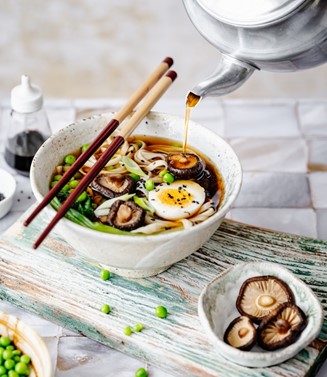Japanese cuisine is known for its delicate balance of flavors, fresh ingredients, and simplicity, making it both delicious and approachable for home cooks. Whether you’re preparing a comforting bowl of ramen, a simple miso soup, or an elaborate sushi platter, having the right ingredients in your kitchen is essential. Many staple Japanese ingredients focus on enhancing the savory, rich taste that defines much of Japanese cooking.
From essential seasonings to key pantry staples, this guide will introduce you to the must-have ingredients that will help you master everyday Japanese cooking at home.
The Power of Authentic Seasoning
At the heart of Japanese cuisine is umami, often described as the “fifth taste” alongside sweet, salty, sour, and bitter. It gives Japanese food its deep, savory richness and enhances the overall flavor profile of a dish. Umami seasoning, which often contains ingredients like kombu (dried kelp), katsuobushi (bonito flakes), shiitake mushrooms, and fermented soy extracts, is a great way to infuse your dishes with that signature Japanese depth of flavor. Some common boosters in Japanese cooking include MSG-based seasonings, miso paste, and dashi stock—all of which play a role in making everyday Japanese meals taste more robust and satisfying.
Soy Sauce (Shoyu – 醤油)
Soy sauce is one of the most fundamental condiments in Japanese cuisine. It provides saltiness and depth to a wide range of dishes, from simple rice bowls to complex broths. There are two main types used in Japanese cooking:
Koikuchi (濃口) – The most common, all-purpose soy sauce used in most recipes.
Usukuchi (淡口) – A lighter, slightly saltier version often used in delicate soups and simmered dishes.
Whether you’re making a teriyaki glaze, seasoning a stir-fry, or dipping sushi, soy sauce is essential for Japanese cooking.
Miso Paste (味噌)
Miso is a fermented soybean paste that adds a deep, salty-sweet richness to Japanese dishes. It’s the key ingredient in miso soup, but also commonly used in marinades, dressings, and stews.
White Miso (Shiro Miso – 白味噌) – Mild and slightly sweet, perfect for soups and dressings.
Red Miso (Aka Miso – 赤味噌) – Stronger and more intense, great for stews and heartier dishes.
Mixed Miso (Awase Miso – 合わせ味噌) – A blend of red and white miso, offering a balanced flavor.
A spoonful of miso can transform simple broths, glazes, and sauces into something rich and full-bodied.
Dashi (だし) – Japanese Stock
Dashi is the base stock for many Japanese soups, stews, and noodle dishes. Unlike Western stocks, dashi has a light yet intensely savory taste and is made in just a few minutes.
The most common types include:
Kombu Dashi – Made from dried kelp (kombu), rich in natural glutamates.
Katsuobushi Dashi – Made from dried bonito flakes, giving a smoky, seafood-like taste.
Shiitake Dashi – A vegetarian-friendly alternative, made with dried shiitake mushrooms.
Dashi is the foundation for dishes like miso soup, udon broth, and chawanmushi (savory egg custard).
Rice (米 – Gohan)
Rice is the backbone of Japanese cuisine, forming the base of countless dishes, from sushi to donburi (rice bowls). The most commonly used rice varieties are:
Short-grain Japanese Rice (Japonica Rice) – Sticky and slightly sweet, perfect for sushi and daily meals.
Sushi Rice (酢飯 – Sumeshi) – Vinegared rice used specifically for sushi.
Brown Rice (玄米 – Genmai) – A healthier alternative with a nutty flavor.
A rice cooker is an excellent investment for perfectly cooked Japanese rice every time.
Mirin (みりん) – Sweet Rice Wine
Mirin is a slightly sweet rice wine that adds depth and a glossy finish to Japanese sauces and marinades. It’s commonly used in:
- Teriyaki sauce
- Simmered dishes (nimono – 煮物)
- Glazes for grilled fish and meats
It enhances flavors without overpowering the dish and helps balance salty soy sauce-based sauces.
Sake (酒) – Japanese Rice Wine
Sake isn’t just for drinking—it’s a key ingredient in Japanese cooking. It’s used to:
- Tenderize meats and fish
- Eliminate strong odors in seafood
- Enhance the flavor in broths and sauces
Cooking sake is less alcoholic than drinking sake and has added salt to prevent consumption as a beverage.
Rice Vinegar (米酢 – Komezu)
Rice vinegar is a mild, slightly sweet vinegar used in many Japanese dishes, including:
- Sushi rice (to add mild acidity and balance sweetness)
- Salad dressings
- Pickled vegetables (tsukemono – 漬物)
It’s less acidic than Western vinegars, making it ideal for delicate Japanese flavors.
Japanese Mayonnaise (マヨネーズ – Kewpie Mayo)
Unlike regular mayonnaise, Japanese mayo (Kewpie brand) has a richer, tangier flavor thanks to egg yolks and rice vinegar. It’s often used in:
- Okonomiyaki (Japanese savory pancakes)
- Takoyaki (octopus balls)
- Salads and sandwiches
The rich nature of Japanese mayo makes it a favorite secret ingredient in many dishes.
Nori (海苔) – Dried Seaweed
Nori is the crispy, dark green seaweed used in:
- Sushi rolls (makizushi – 巻き寿司)
- Rice balls (onigiri – おにぎり)
- Ramen toppings
It has a slightly salty, oceanic flavor and adds both texture and full bodied-flavor to Japanese dishes.
Wasabi (山葵) – Japanese Horseradish
Wasabi is the spicy, green condiment typically served with sushi. It has a sharp, clean heat that enhances the flavor of fish and meats. Fresh wasabi is rare outside Japan, but many brands offer wasabi paste or powder for home use.
Build Your Japanese Pantry
With just these ten essential ingredients, you can create authentic, flavorful Japanese dishes from your own kitchen. Stocking up on these staples will make everyday Japanese cooking easier, tastier, and more rewarding.
Ready to start your journey into Japanese cuisine? Experiment with these ingredients and bring the delicious flavors of Japan to your home!









